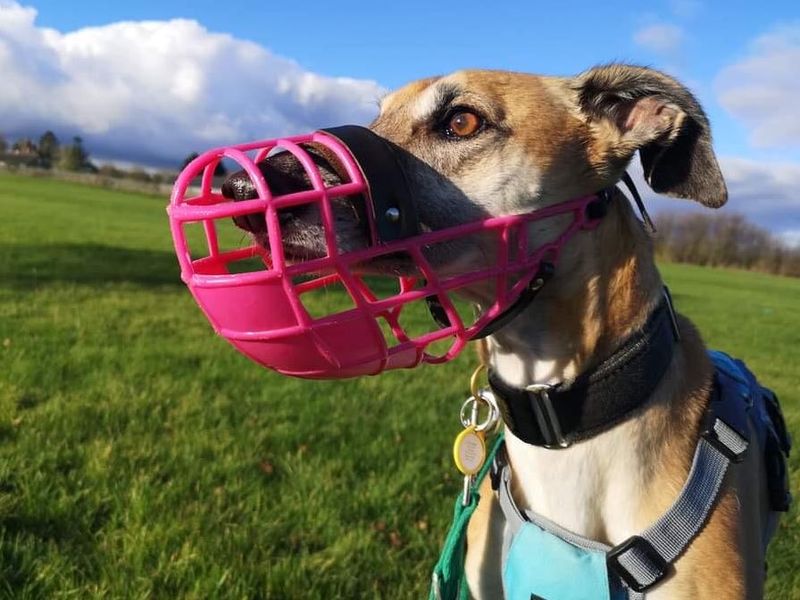How to train your dog to wear a muzzle
Step-by-step guide: how to muzzle train your dog.

It’s useful for all dogs to be able to wear a muzzle comfortably. Dogs can learn to enjoy wearing muzzles in the same way that they learn to wear a collar or harness. Take the time to introduce a muzzle in a positive and fun way, so your dog knows it’s nothing to worry about.
Why would my dog need to wear a muzzle?
There are lots of reasons a dog may benefit from wearing a muzzle, including:
- For safety when a dog is frightened, ill or injured. Fear, pain or illness can affect the way a dog feels and behaves. If your dog is already muzzle trained, a vet can provide care quickly and safely in an emergency.
- To prevent dogs eating things that could be harmful. For dogs on strict diets, or those who try to eat everything, a muzzle could be a life saver.
- To keep dogs, and those around them, safe. A muzzle can be essential for dogs who have been known to behave aggressively in certain situations, or dogs who have learnt to chase and catch.
- If they are required to by law.
A muzzle won't change the way your dog feels about a particular situation or trigger.
Even with a muzzle on, it’s important to try to avoid situations that make your dog feel worried. Being exposed to scary situations is unpleasant for them and could make their behaviour worse in the long term.
Choosing a muzzle
There are lots of types of muzzles. Choose a muzzle that your dog can eat, drink and pant through, such as a basket type muzzle. Being able to pant is important for dogs to regulate their temperature. The muzzle needs to fit them comfortably — it shouldn't obscure their vision, dig into their face, or restrict their mouth movement. It needs to be secure and as comfy as possible. If it’s rubbing, you can try wrapping a non-irritant fabric around the inside of the nose-piece.
How to train your dog to wear a muzzle
If your dog isn’t comfortable having people close to their food bowl, or can resource guard food, then this method may not be suitable for you and we recommend you contact and an accredited behaviourist for support. If you know your dog struggles with having their face or head touched, you’ll need to work on this first with the support of a qualified professional.
How to train your dog to wear a muzzle, step-by-step
Introduce the muzzle
When you’re starting training, always make sure your dog is free to remove their face from the muzzle whenever they wish. Give them the choice to put their nose in and out and move away, this will help build their confidence and trust in you.
Begin training in a …
Learning to love the muzzle
Show your dog the muzzle — at this point they should be happy to put their nose into it.
Slowly build up the time your dog spends in the muzzle: post treats or paste through the end of the muzzle while they choose to stay in position.
You can also …
Add in movement
To help your dog feel confident walking in the muzzle, it’s important to start building in some movement.
Repeat what you've been doing, and take a step or two backwards while holding the muzzle. This will encourage your dog to walk with you. Reward your dog with …
Introducing the straps
Don’t rush to do up the straps of your muzzle, give your dog plenty of time to get familiar with the sound and feeling of the muzzle first.
First, make sure your dog is comfortable with the noise of the clip or buckle (as this will eventually be done up …
Doing up the straps
When your dog is happy keeping their nose in the muzzle with you holding the straps, begin to fiddle with the clips. There’s no need to rush into doing up the strap completely. Start by moving the straps around behind your dog’s ears as though you are going to do it up — but …
Leaving the muzzle on for longer
Now that your dog is relaxed and confident wearing the muzzle with the straps done up, begin leaving the muzzle on for increasing periods of time. Start with just a few seconds, and then increase in very small increments.
Build in some fun activities for your …
Keep refreshing your training
Redo these steps every so often to help your dog keep a positive association with their muzzle. Even dogs who wear a muzzle everyday can benefit from a refresher.
What to do if my dog is worried by the muzzle
The muzzle might worry your dog so much that they decide the treat isn’t worth it. They might have worn a muzzle before and not enjoyed it. Or they might be naturally cautious about trying something new. They may also be worried if someone is holding a muzzle.
In this case, put the muzzle on the floor and drop the treats near it. See if your dog will eat the treats then. As your dog gains confidence, you can gradually place the treats closer to the muzzle. If your dog has mobility issues or would struggle to reach the floor, you could zip tie the muzzle to a chair or table leg.
If your dog is still worried and won’t go near the muzzle, speak to your vet.
It’s well worth taking some time to change your dog’s feelings about the muzzle. You should find that doing so helps in other areas of your dog’s life too.
What if my dog tries to remove the muzzle or keeps rubbing it?
If your dog starts rubbing or pawing at the muzzle to try to remove it, try to engage them in something else to distract them. Then, remove the muzzle and go back a stage, to when they were relaxed. Keep repeating that stage for a while to build their confidence before trying to progress again. When you do, go slower.
Once your dog is relaxed and confident wearing a muzzle, some rubbing of their face can be normal. But if your dog’s skin seems irritated or sore, or they can’t behave normally while wearing it (they should be able to eat and drink through it), then it might mean the size, shape, or material of the muzzle is not right for your dog. Speak to your vet for advice on finding the right muzzle.
What if I need to use a muzzle before my dog is ready?
If you've started your training and you need to fully muzzle your dog for any reason, use a completely different style of muzzle. If you’re at the vet, they might have a selection available. Use a different muzzle for this short intervention to minimise disruption to training with your dog’s own muzzle.
Will people and dogs treat my dog differently if they’re wearing a muzzle?
Some people may give dogs wearing muzzles a wider berth — but depending on why your dog is wearing their muzzle, this can actually be a benefit! If your dog feels worried around other dogs or people for example, more space may be helpful.
If your dog is relaxed around other dogs, gradually introduce them with their muzzle on. When your dog interacts with other dogs, watch their body language to make sure everyone is relaxed and confident. Read our body language guide to learn the signs to look for.
Once your dog is happy to wear their muzzle, they will be able to have just as much fun on walks and enjoy their time outdoors.
If you have certain types or breeds of dog there are additional rules you must follow, in accordance with the Control of Dogs Regulations 1998. This applies to the following types of dog, as well as strains or cross-breeds of these breeds:
- American Pit Bull Terrier
- English Bull Terrier
- Staffordshire Bull Terrier
- Bull Mastiff
- Dobermann Pinscher
- German Shepherd (Alsatian)
- Rhodesian Ridgeback
- Rottweiler
- Japanese Akita
- Japanese Tosa
- Bandog
This means that while in a public place these dogs, or strains and crosses thereof, must be:
- Wearing a muzzle
- Kept on a short strong lead (under 2m)
- With someone over the age of 16, who is capable of controlling them
- Wearing a collar with the name and address of their owner


